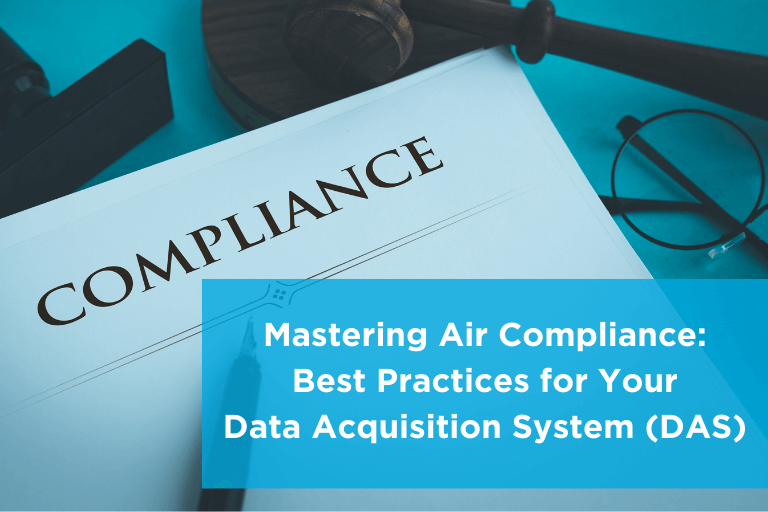The Role of a Data Acquisition System (DAS) in Compliance
Environmental regulations are a complex landscape that requires precision when navigating the intricacies of air compliance. The cornerstone of this journey is the effective management of your Data Acquisition System (DAS).
The DAS serves as the brain of your Continuous Emissions Monitoring System (CEMS), collecting and managing data from various monitoring systems. This includes emissions monitoring, parametric monitoring, opacity monitoring, and more. Unlike a passive data logger, a true DAS also validates data, performs calculations in real-time, and provides access to alarms and data as they occur.
Understanding Regulatory Obligations
Industries find themselves under the umbrella of various regulatory frameworks such as 40 CFR Part 60, Part 75, and Part 63. Compliance relies on an in-depth understanding of the complex regulations that your facility is subject to.
Regardless of P60, 63, or 75 rules, operating permit interpretations can become fixed, are specific to your particular facility, can reconcile clashing rules consent decrees, or may be more strict. Therefore, good communication and consistency are essential to meet the expectations of federal, state, and local air agencies.
40 CFR Part 60 General Obligations
40 Part 75 General Obligations
40 CFR Part 63 Obligation
According to the Code of Federal Regulations, “data collected during CPMS breakdowns, out-of-control periods, repairs, maintenance periods, instrument adjustments or checks to maintain precision and accuracy, calibration checks, and zero (low-level), mid-level (if applicable) and high-level adjustments.”
Guidelines for Your Data Acquisition System
1. Monitoring Plans and System Configuration
If the Data Acquisition System is the brain of your system, the Monitoring Plan is the heart. In order to keep your system healthy, there are a few parameters that you must follow in regard to your Monitoring Plans:
- Know them: current methodology, equipment, formulae
- Reconcile and update them: modifications, values, date/hour entries, etc.
- Have access to them: electronic and hard-copy
- Make checklists from them: periodic walkdowns are requirements for any system (daily, weekly, monthly, quarterly, semiannual, or annual)
Monitoring Plans guide the configuration of your DAS. If you have a concise Monitoring Plan, you’re good as gold. If you have an upcoming DAS audit, the Monitoring Plan is the first document that the auditors are going to ask for. This leads to them looking at your plant configuration, stack configuration, serial numbers, and monitored parameters. If any of those elements are incorrect, it is considered a violation. This is why it’s vital to your plant that you update your Monitoring Plan on a quarterly basis.
2. Efficient Data Flow and Automation
Efficient data flow within a DAS is paramount, and manual data calculations in spreadsheets can lead to errors. Errors can occur in spreadsheets if your DAS is not programmed appropriately or is not set up with a module that your facility requires. The purpose of the DAS is to take this flow of data, calculate it, and present a report in a format that can be used for submittal. So, if you find yourself manually pulling minute-by-minute data, compiling the data into a spreadsheet, and executing the emissions calculations, you might consider going back to your DAS binder to review your particular emissions monitoring requirements to see if there’s a way to automate your monitoring.
3. Optimizing Maintenance for Compliance
As outlined above, spreadsheets leave a large margin for error, especially when it comes to validating your data. Generally, this means your status flags that are associated with good vs. bad data or valid data vs. invalid data. If your facility experiences a maintenance event, the goal is to minimize analyzer downtime.
A tip that we recommend for maintenance is activating “maintenance mode.” Maintenance mode only required two quadrants and an hour. So, you can optimize two hours to successive hours, activate “maintenance mode” on your CEMS on the 16th minute of that first hour, and move all the way to the 44th minute of the second hour. Resulting in an hour and a half worth of maintenance with two valid hours.
4. Best Practices for Collaboration
Collaborative approaches to compliance are pivotal to your facility’s success. This means that routine checks, monthly team compilations, and sharing information through an open communication path are essential when assuring that your data, processes, etc., are consistent through all departments.
Allowing open communication across the DAS users at your facility ensures efficient error correction and strengthens your overall compliance framework.
5. Mastering Emissions Calculations
Each system has a different program, and your air permit calculations are programmed to demonstrate compliance with your particular permit requirements. In StackVision, generating a calculation report is a click away—making audits much easier.
If you have more than one stack, you should code compare your equations. If one does not resemble the other, take the time to start asking questions and re-review your permit requirements. Any DAS platform in use should be able to demonstrate proper calculation capability; further, individuals should be able to prove the math of their calculations at will—not only using wizards or utilities available at their desks but also using ECMPS as a benchmark for making sure your calculations are concise.
6. Navigating Multi-Hour Averages and Data Management
Stepping back to 40 CFR Part 60, we’re addressing hourly averaging. This is covered under statute 60.13, which covers continuous monitoring averaging. You should be able to answer whether you have an hourly average that is based on arithmetic averaging. Meaning that it uses all the minutes of the hour to average, or does it use integrated averaging, which refers to valid quadrants.
Switching gears to calculating multi-hour average, here are some questions you should be able to answer:
- How many hours do I need?
- Am I able to exclude data based on startup, shutdown, or malfunctions?
- Am I creating a multi-hour average? Or is it cumulative total? Is it rolling? Is it block?
- Is it based on operating time vs. an operating hour for validity?
- Do I have to be online to create this multi-hour average or multi-hour total?
Considering data storage and retrieval, generally, you should keep at least two years of your data active, but preferably five years. For auditing and agency purposes, it’s important to know that if you have a hiccup in your communications, you’re still able to retrieve the missing data quickly and easily.
Mastering Daily Checks for Optimal DAS Performance
Overall, having familiarity with each element of your Data Acquisition System is the biggest takeaway. This means enacting daily checks for your data logger or data controller and your other emissions equipment. This way, your ability to recover from server crashes, issues with data collection or validation, downtime, etc., will be inconsequential. For resources on making checklists for your facility, you can check out our Recommended Monitoring Plan Checklists and the CEMS Data Review Checklists on our blog, The Source.
Understanding how your system harmoniously works together to gather, monitor, and calculate your emissions from start to finish will safeguard your compliance.
How Can ESC Spectrum Help?
Data Acquisition Systems are the pinnacle of our business. With over 3,100 air emissions sources in a variety of industries relying on our StackVision DAS for monitoring and reporting, our DAS speaks for itself. StackVision works seamlessly with the 8864 Data Controller to collect, monitor, QA, and report on emissions data.
Having issues understanding your regulatory obligations? Our Regulatory and Reporting team is here to help with any of your needs. From Electronic Data Reports (EDRs), Permit Compliance Reports, and Data Reviews to QA/QC Plans, Monitoring Plans, and DAS Audits, our team is up for the challenge.
We also offer a plethora of CEMS and DAS training options including in-person general training, customized private training classes, or comprehensive online training with our StackVision Success Program.
To learn more about our DAS, regulatory and reporting services or training offerings, contact us today.
Interested in learning more about regulations and staying in compliance? Read our Definitive Guide to Air Emissions Regulations.

Reagan Sokolosky - Marketing Specialist III
Reagan is a Strategic Communications graduate from Oklahoma State University who joined ESC Spectrum in April of 2020. She dove headfirst into the air emissions compliance industry with no prior experience. She has been writing and researching about air emissions for 4 years to educate our customers. Within four years, Reagan advanced to Marketing Specialist III, showcasing expertise in ESC Spectrum’s learning offerings, email marketing, video editing, product and software releases, and company rebranding.


